
Joye M.Cryptographic hardware and embedded systems.2005
.pdf
196 C.D. Walter
In the case of multiplying two independent, random residues X and Y, the probability of the conditional subtraction is  for equi-distributed Z, namely
for equi-distributed Z, namely
However, for the standard exponentiation algorithm of Fig. 1, the point doublings require field multiplications by a fixed constant, namely a coordinate of the initial (plaintext) point P. If  is the probability of the final subtraction when multiplying a random input X by a constant C, then
is the probability of the final subtraction when multiplying a random input X by a constant C, then  so that
so that
The different coefficients of  in these three equations enable the different operations to be distinguished by their subtraction frequencies when a number of exponentiations occur with the same secret key
in these three equations enable the different operations to be distinguished by their subtraction frequencies when a number of exponentiations occur with the same secret key  [19,16]. Here cases will be selected where C has the most extreme values in order to force final subtraction behaviour that proves two products have different inputs.
[19,16]. Here cases will be selected where C has the most extreme values in order to force final subtraction behaviour that proves two products have different inputs.
6Side Channel Leakage
In addition to the assumptions about the algorithms used, in this instance of the attack, it is supposed that every occurrence of the conditional subtraction in MMM can be observed. With good monitoring equipment and a lack of other hardware counter-measures, successive data loading cycles can be observed and hence the operations timed, thereby enabling the occurrences to be deduced.
Previous authors have described in detail how timing and power attacks can be performed [10,11,5,15,6]. In fact, all we require here is a reasonable probability of determining whether or not two given instances of modular multiplication have the same pair of inputs. This might be done equally well by power or EMR analysis rather than by timing – the power consumption curves may be sufficiently characteristic of the inputs for this to be possible [20]. Furthermore, this property of distinguishability may occur for any modular multiplier, implying that the attack described here is not restricted only to Montgomery multipliers.
7Distinguishing Doublings from Additions
To provide outline theoretical justification for the later experimental results, in this section a particular single signing or decryption is selected from a randomly generated set of samples. This selection has properties which increase the number of point operations that can be definitely determined as additions or doublings
TEAM LinG
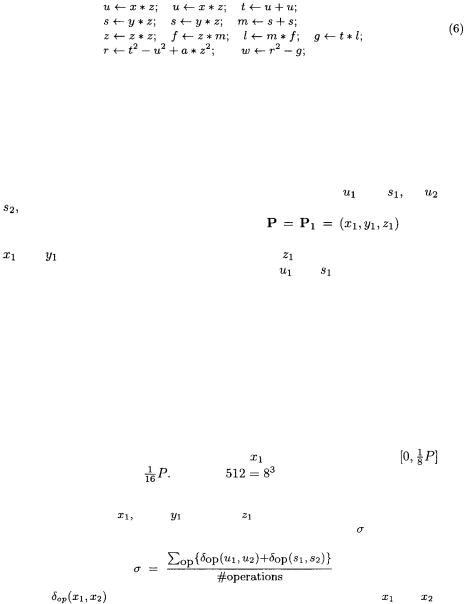
Simple Power Analysis of Unified Code |
197 |
from knowledge of the conditional subtractions. Consequently, for this choice there is a reduction in the computational effort to traverse the space of possible keys and recover the key used.
Brier and Joye [3] provide an algorithm for computing  by imposing a suitable ordering on equations (2). In the case of the point doubling operation with
by imposing a suitable ordering on equations (2). In the case of the point doubling operation with  the arithmetic of (2) specialises to:
the arithmetic of (2) specialises to:
Here the first two applications of MMM are identical, as are the second two. So both pairs exhibit identical behaviour with respect to the occurrence of the final conditional subtraction. It is the repeated or different behaviour within the pairs which creates the handle for an attack. If the recorded behaviour is different at these points, the curve operation must be a point addition.
From a sample of signatures or decryptions, the attacker starts by selecting the case which has the smallest number of undetermined operations. The initial,  way to do this is just to count the total number of operations, and subtract
way to do this is just to count the total number of operations, and subtract
the number of those for which the computations of either |
and |
or |
and |
or both, involve differences regarding the final subtraction. |
|
|
|
Point additions involve the initial input |
|
where the |
|
natural variation in random (or randomized) coordinates means that occasionally
and will both be small (i.e. close to 0) and |
will be large (i.e. close to P). |
By equation (5), this means the computations of |
and in (2) will be less likely |
than average to include the additional subtraction, while the computations of  and
and  will be more likely than average to include the additional subtraction. For such initial P, this enhances the likelihood of different behaviour with respect to subtractions in these pairs of multiplications, thus increasing the number of point operations which can be definitely determined to be additions rather than doublings.
will be more likely than average to include the additional subtraction. For such initial P, this enhances the likelihood of different behaviour with respect to subtractions in these pairs of multiplications, thus increasing the number of point operations which can be definitely determined to be additions rather than doublings.
Such a point is used below to develop some theory3. But, in fact, with the selection criterion above and others developed later, the attacker is actually likely to choose a case which is much more amenable to an attack than that where P has such extreme coordinates.
Suppose the sample size is 512. This is a reasonably practical number of
samples to obtain. In one eighth of cases, |
will lie in the interval |
|
and |
||||
have an average value of |
So, from |
cases we can expect one instance |
|||||
where the initial input is |
|
|
|
|
|
||
|
|
|
|
|
|||
3 A case with small |
small |
and large |
is almost always obtained by choosing |
||||
the side channel trace which maximises the |
average number |
of differences per |
|||||
operation: |
|
|
|
|
|
|
|
where |
is 1 or 0 depending on whether or not the products |
and |
differ |
||||
with respect to the occurrence of a final subtraction in operation |
op of a complete |
||||||
point multiplication. |
|
|
|
|
|
|
|
TEAM LinG
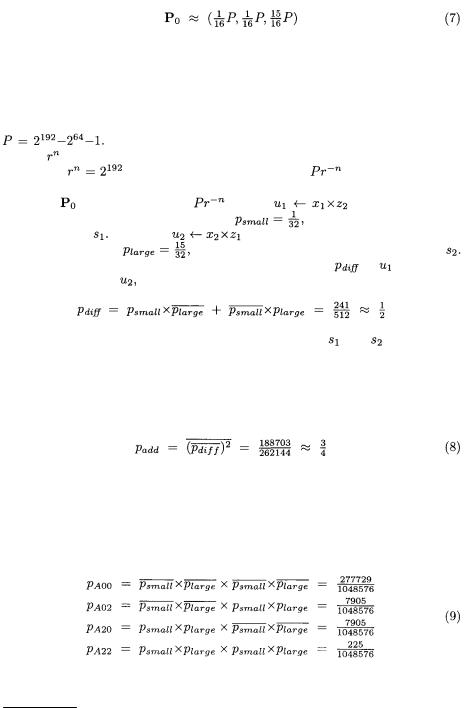
198 C.D. Walter
 is always an input, say
is always an input, say  to each point addition. It is constant over the set of all point additions of the associated signing or decryption. The other input,
to each point addition. It is constant over the set of all point additions of the associated signing or decryption. The other input,  for these point additions is, for all practical purposes, a point with random coordinates. Hence (5) is the formula to apply.
for these point additions is, for all practical purposes, a point with random coordinates. Hence (5) is the formula to apply.
For each of the example EC-DSA curves [2] over a field of odd characteristic
P, the field order |
is a generalized Mersenne prime. For example, P-192 uses |
||||||
|
|
Consequently, P is very close to a large power of 2 and, in |
|||||
MMM, |
will certainly be taken equal to that power of 2 (except perhaps for |
||||||
P-521). So |
|
|
for P-192. Therefore, the ratio |
|
will be essentially 1 |
||
for most EC-DSA curves used in practice. |
|
|
|
||||
Using |
and |
this value for |
in (5), |
|
incurs a final sub- |
||
traction with probability approximately |
and the same holds for the |
||||||
computation of |
Similarly, |
incurs a final subtraction with proba- |
|||||
bility approximately |
|
and the same holds for the computation of |
|||||
As the different inputs are independent, the probability |
of |
incurring a |
|||||
subtraction but not |
or vice versa, is |
|
|
|
|||
There is the same probability of distinguishing between |
and |
in this way. |
|||||
As the outputs from the loop of MMM are uniformly distributed over an interval of length P, the subtractions for the four products are all independent of each other even though some share a common input. So the probability of proving that a point addition occurs as a result of observing differences in subtractions for at least one of the pairs is4
of proving that a point addition occurs as a result of observing differences in subtractions for at least one of the pairs is4
In a similar way, one can obtain the probabilities  and
and  of a point addition displaying, respectively, no subtractions, no subtractions for two multiplications then two subtractions, two subtractions then no subtractions, and four subtractions. These are the cases where the subtractions leave it ambiguous as to whether the operation is a point addition or a point doubling. For the fixed input
of a point addition displaying, respectively, no subtractions, no subtractions for two multiplications then two subtractions, two subtractions then no subtractions, and four subtractions. These are the cases where the subtractions leave it ambiguous as to whether the operation is a point addition or a point doubling. For the fixed input  given in (7) and a random input
given in (7) and a random input 
In the case of a (random) doubling, the field multiplications of interest have two independent random inputs and so, by (4), the corresponding probabilities are:
4 The accuracy here and later is absurd, but it should enable readers to understand and check the calculations more easily.
TEAM LinG
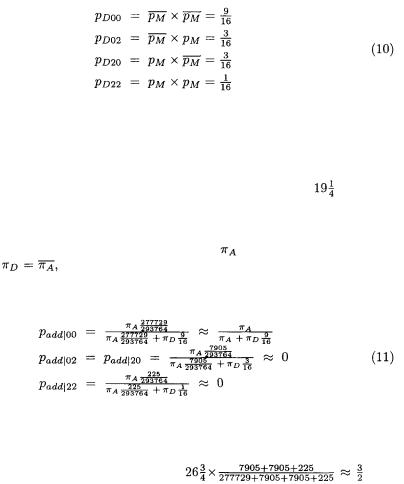
Simple Power Analysis of Unified Code |
199 |
These last probabilities sum to 1 because it is not possible for the multiplications within a pair to behave differently.
By (8), about three quarters of the additions are determined immediately. On average, this leaves about  additions unrecognised for P-192 (30 if the sample size is reduced to only 64). In fact, simulations below in Table 2 show
additions unrecognised for P-192 (30 if the sample size is reduced to only 64). In fact, simulations below in Table 2 show
that the attacker, with a better selection criterion, has a mere |
additions |
unrecognised for the same sample size of 512. |
|
For undetermined cases, the number of final subtractions can still be used to make a probabilistic decision between an add or a double. Suppose an operation
is known to be a point addition with probability |
and a point doubling with |
||
probability |
and the subtractions do not distinguish the operation as |
||
an addition. Using the same notation as above for counting subtractions, |
the |
||
probabilities of a point addition in the various cases can be deduced from |
(9) |
||
and (10) as: |
|
|
|
Consequently, no subtractions are most likely in such a situation, and the bias to one or other depends on the context, such as neighbouring operations, which might influence the value of In the unlikely event of two or four subtractions, the attacker would be unfortunate if more than one or two such operations were not doublings: on average he expects only such operations for P-192.
In the unlikely event of two or four subtractions, the attacker would be unfortunate if more than one or two such operations were not doublings: on average he expects only such operations for P-192.
8Reconstructing the Secret Key
This section covers both the deduction of unclear key bits from the overall structure of the point operations, and a search of the subspace of keys which are consistent with that structure and with previously determined operations.
Again, for this section, numerical examples apply to the standard P-192 curve defined in FIPS 186-2 [2] for EC-DSA. This has the advantage of a short key length. The methods apply in exactly the same way to other curves, but it will become evident that larger fields require more computational effort.
From Fig. 1, the structure of point operations during signing or decryption can be viewed as a string S over the alphabet {A, D} in which the first character of S is ‘D’ (a double), each ‘A’ (an add) is preceded by a ‘D’ and there are a known, fixed number of occurrences of ‘D’, namely N–1 where N is the number of bits in the key  On average, there will be
On average, there will be  ‘A’s, but for each case
‘A’s, but for each case
TEAM LinG
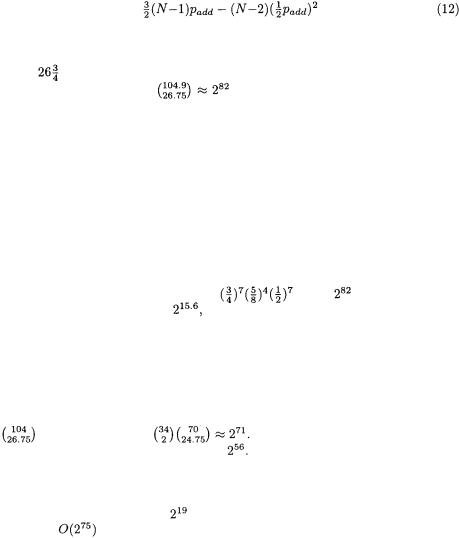
200 C.D. Walter
this can be established exactly by taking the total number of operations (the length of S) and subtracting the number of doublings.
By (8), a substantial number of the ‘A’s are known. Each known ‘A’ determines its neighbours as ‘D’ on either side (see Table 1). Some occurrences of ‘D’ are determined by two ‘A’s. The probability of this for an interior ‘D’ is  Neglecting differences caused by end conditions (such as the last ‘A’ is, or is not, followed by a ‘D’ and the initial ‘D’ is known), the total number of
Neglecting differences caused by end conditions (such as the last ‘A’ is, or is not, followed by a ‘D’ and the initial ‘D’ is known), the total number of
determined operations is, on average, about
For the on-going P-192 example, about  additions are determined from the subtractions and so, by (12), around 181.6 operations in total. This leaves
additions are determined from the subtractions and so, by (12), around 181.6 operations in total. This leaves
about |
‘A’s to allocate among approximately 286.5–181.6 = 104.9 unknown |
|
positions – |
approximately |
choices. However, these choices cannot |
be made freely. |
|
|
Two thirds of the string S is |
accurately determined as above. This leaves |
|
a number of short substrings to be guessed. These are restricted to patterns which do not have consecutive ‘A’s. For our parameter choices, the number of these substrings decreases exponentially with their length. So, most frequently, the unknown substrings are of length 1. They can be either ‘A’ or ‘D’. Each possibility can occur. However, substrings of length 2 are constrained to ‘AD’, ‘DA’ or ‘DD’, and those of length 3 to only ‘ADA’, ‘ADD’, ‘DAD’, ‘DDA’ or ‘DDD’. So only  of choices are possible for length 2 substrings, only
of choices are possible for length 2 substrings, only  for length 3, and one half or less for longer substrings. (The numerators go up in a Fibonacci sequence: 2, 3, 5, 8, 13,...; and the denominators in powers of two.)
for length 3, and one half or less for longer substrings. (The numerators go up in a Fibonacci sequence: 2, 3, 5, 8, 13,...; and the denominators in powers of two.)
In the P-192 example, about 7 substrings of length 2 occur, 4 of length 3,
and 7 of longer lengths. So fewer than |
of the |
choices, and, more |
|
precisely, only roughly one in |
satisfies the constraint of preceding each ‘A’ |
||
by a ‘D’ (see Table 2). The search space is therefore reduced to under 
In allocating the ‘A’s, we can also note that ‘D’ is much more likely in some cases, and ‘A’ perhaps in others. For example, by (10),  of doubles will exhibit 2 or 4 subtractions, but, by (11), very few operations with this behaviour could be additions. In the example, about
of doubles will exhibit 2 or 4 subtractions, but, by (11), very few operations with this behaviour could be additions. In the example, about  doubles can be so identified with high probability and on average it is only necessary to try up to 2 of them as doubles. Thus, in estimating the computational effort, the
doubles can be so identified with high probability and on average it is only necessary to try up to 2 of them as doubles. Thus, in estimating the computational effort, the
can be replaced by |
With the substring constraints, this |
now reduces the search space to below |
|
Suppose each key in the search space is checked by applying it once in a point multiplication – some 286.5 point operations, each containing 18 field multiplications. With 32-bit arithmetic, MMM requires 6×(1+6×2) = 78 native machine
multiplications. Thus, about |
MULs are required per key, giving a time com- |
|
plexity of |
machine multiplications to break one member of the sample of |
|
512 P-192 signings/decryptions. This is probably not yet computationally feasibility at  IV years, although it could be distributed easily over a number of machines. However, ...
IV years, although it could be distributed easily over a number of machines. However, ...
TEAM LinG
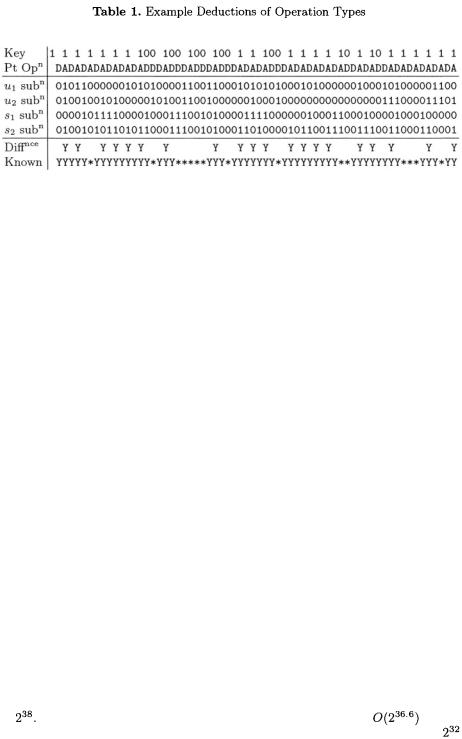
Simple Power Analysis of Unified Code |
201 |
9Worked Examples
This section provides more detail for a typical P-192 attack and assesses the impact of changing various parameters. In particular, the attacker invariably chooses very much better examples than those of the previous section, showing that the attack is, in fact, already feasible. Sequences of conditional subtractions were simulated using equations (3)–(5) and continuous mathematics on randomly generated keys  and inputs P. Different sized samples were generated and one member selected to:
and inputs P. Different sized samples were generated and one member selected to:
minimize the number of point operations which were not distinguishable as additions by virtue of the conditional subtractions, nor distinguishable as doublings by adjacency to a known addition.
Table 1 shows the initial few bits, point operations, conditional subtractions and deductions for a typical example selected using this criterion. There is one column for each point add (A) or double (D). The penultimate row records differences (marked Y) within the first or the second pair of subtractions. These are all adds and the final row extends this to include the doubles on either side of a known add. The attacker computes this for each signature, and chooses the one with the fewest unknowns (marked  in the last line.
in the last line.
Table 2 shows how the average number of undetermined operations in the selected sequence varies according to the sample size from which it is taken. The most significant benefit from larger samples is the decrease in the total number of indeterminate operations. The undetermined point additions,  in number, must be chosen from the undetermined operations,
in number, must be chosen from the undetermined operations,  in number. The number of such combinations is given lower in the table. The longer substrings of unknown operations have more pattern restrictions. The average factor by which this cuts the search space is given in the penultimate line, and the last line presents the resultant overall order of the search space. The computational effort is this multiplied by the work involved in verifying a single key.
in number. The number of such combinations is given lower in the table. The longer substrings of unknown operations have more pattern restrictions. The average factor by which this cuts the search space is given in the penultimate line, and the last line presents the resultant overall order of the search space. The computational effort is this multiplied by the work involved in verifying a single key.
The figures make it clear that the criterion just given for selecting the side channel trace is hugely more powerful than if an extremal initial point P were used. For the sample size of 512, there is a reduction in workload by a factor
of |
This means that the computational effort is reduced to |
native |
multiplications, i.e. about a minute on a Pentium IV processor running |
at |
|
TEAM LinG

202 C.D. Walter
cycles per second. This is certainly feasible for any back street attacker with access to suitable monitoring equipment, not just for government organisations. Indeed, less than a week of computing reveals 1 in 32 keys.
The table also shows that twice as many keys can be extracted from a given sample for about 10 times the effort – the easiest keys are found first, after which they become steadily more difficult to find.
Finally, in Table 3 a comparison is made of the search spaces for the other recommended EC-DSA curve sizes5. It would appear that it is still computationally feasible to attack some keys over fields as large as that of P-256.
5Here  is assumed to be essentially 1. However, 521-bit numbers cannot be partitioned into words of equal length without loss. So, for P-521,
is assumed to be essentially 1. However, 521-bit numbers cannot be partitioned into words of equal length without loss. So, for P-521,  may not be close to 1. This would result in many fewer final subtractions and so more unknown
may not be close to 1. This would result in many fewer final subtractions and so more unknown
operations than tabulated.
TEAM LinG
Simple Power Analysis of Unified Code |
203 |
10 Conclusion
The clear conclusion is that, on its own, unified code for point operations provides insufficient security in some standard implementations of ECC which employ arithmetic hardware that is subject to side channel leakage. In particular, we demonstrated the feasibility of attacking hardware that uses a time-varying implementation of Montgomery modular multiplication with the Brier-Joye formulae for point addition [3].
Several easy counter-measures would defeat the attack. For example, it should be possible to re-code the point evaluation to avoid repeated field operations when a doubling occurs. The formulae of [7] and [8] avoid the problem, but have field squares precisely when a doubling occurs – leaky hardware might still reveal this. Alternatively, picking any other exponentiation algorithm than the standard binary one may reduce or entirely eliminate the bias given in some decryptions as a result of re-using an extremal input in every point addition. Thus, using  exponentiation with
exponentiation with  would reduce the frequency of weak cases as well as introducing ambiguities about which point addition is being performed. Certainly, using a more leak-resistant multiplier would improve matters.
would reduce the frequency of weak cases as well as introducing ambiguities about which point addition is being performed. Certainly, using a more leak-resistant multiplier would improve matters.
However, the three standard counter-measures listed by Coron [4] are insufficient here; they may make no difference or even make the attack more feasible. Key blinding only helps if more than one decryption is required for key recovery. Only one decryption was used here, but if side channel leakage is weak then several decryptions with the same key could help to distinguish additions from doublings with enough certainty for it to be computationally feasible to search the key space. So this counter-measure might ameliorate the situation, although not solve it. Message blinding only helps against chosen ciphertext attacks, but that was not required here. Indeed, the third counter-measure of randomizing the input point coordinates may help the attack to succeed by guaranteeing a uniform distribution of coordinate values which will contain the necessary examples of attackable extremal points.
Previously it was uncertain that time variation was a serious threat except when unblinded keys were used at least several hundred times in an embedded cryptographic device [19]. Now it is clear that constant time modular multiplication is essential for security even when secret keys are always blinded.
References
1.Portable data carrier including a microprocessor, Patent no. 4211919 (Abstract), US Patent and Trademark Office, July 8, 1980.
2.Digital Signature Standard (DSS), FIPS PUB 186-2 (Appendix 6), U.S. National Institute of Standards and Technology, 27 Jan 2000.
3.E. Brier & M. Joye, Weierstraß Elliptic Curves and Side-Channel Attacks, Public Key Cryptography (Proc. PKC 2002), D. Naccache & P. Paillier (editors), LNCS 2274, Springer-Verlag, 2002, pp. 335–345.
4.J.-S. Coron, Resistance against Differential Power Analysis for Elliptic Curve Cryptosystems, Cryptographic Hardware and Embedded Systems (Proc. CHES
99), C. Paar & Ç. Koç (editors), LNCS 1717, Springer-Verlag, 1999, pp. 292–302.
TEAM LinG
204 C.D. Walter
5.J.-F. Dhem, F. Koeune, P.-A. Leroux, P. Mestré, J.-J. Quisquater & J.-L. Willems,
A practical implementation of the Timing Attack, Proc. CARDIS 1998, J.-J. Quisquater & B. Schneier (editors), LNCS 1820, Springer-Verlag, 2000, pp. 175– 190.
6.K. Gandolfi, C. Mourtel & F. Olivier, Electromagnetic Analysis: Concrete Results,
Cryptographic Hardware and Embedded Systems – CHES 2001, Ç. Koç, D. Naccache & C. Paar (editors), LNCS 2162, Springer-Verlag, 2001, pp. 251–261.
7.C. Gebotys & R. Gebotys, Secure Elliptic Curve Implementations: An Analysis of Resistance to Power-Attacks in a DSP Processor, Cryptographic Hardware and Embedded Systems – CHES 2002, B. Kaliski, Ç. Koç & C. Paar (editors), LNCS 2523, Springer-Verlag, 2003, pp. 114–128.
8.M. Joye & J.-J. Quisquater, Hessian Elliptic Curves and Side Channel Attacks,
Cryptographic Hardware and Embedded Systems – CHES 2001, Ç. Koç, D. Naccache & C. Paar (editors), LNCS 2162, Springer-Verlag, 2001, pp. 402–410.
9.N. Koblitz, Elliptic Curve Cryptosystems, Mathematics of Computation 48, 1987, pp. 203–209.
10.P. Kocher, Timing attack on implementations of Diffie-Hellman, RSA, DSS, and other systems, Advances in Cryptology – CRYPTO ’96, N. Koblitz (editor), LNCS 1109, Springer-Verlag, 1996, pp. 104–113.
11.P. Kocher, J. Jaffe & B. Jun, Differential Power Analysis, Advances in Cryptology
– CRYPTO ’99, M. Wiener (editor), LNCS 1666, Springer-Verlag, 1999, pp. 388– 397.
12.P.-Y. Liardet & N. P. Smart, Preventing SPA/DPA in ECC Systems using the Jacobi Form, Cryptographic Hardware and Embedded Systems – CHES 2001, Ç. Koç, D. Naccache & C. Paar (editors), LNCS 2162, Springer-Verlag, 2001, pp. 391–401.
13.V. Miller, Use of Elliptic Curves in Cryptography, Advances in Cryptology – CRYPTO ’85, H. C. Williams (editor), LNCS 218, Springer-Verlag, 1986, pp. 417– 426.
14.P. L. Montgomery, Modular Multiplication without Trial Division, Mathematics of Computation 44, no. 170, 1985, pp. 519–521.
15.J.-J. Quisquater & D. Samyde, ElectroMagnetic Analysis (EMA): Measures and
Counter-Measures for Smart Cards, Smart Card Programming and Security (Proc. e-Smart 2001), I. Attali & T. Jensen (editors), LNCS 2140, Springer-Verlag, 2001,
pp. 200–210.
16.W. Schindler, A Combined Timing and Power Attack, Public Key Cryptography (Proc. PKC 2002), P. Paillier & D. Naccache (editors), LNCS 2274, SpringerVerlag, 2002, pp. 263–279.
17.W. Schindler & C. D. Walter, More detail for a Combined Timing and Power Attack against Implementations of RSA, Cryptography and Coding, K.G. Paterson (editor), LNCS 2898, Springer-Verlag, 2003, pp. 245–263.
18.C. D. Walter, Precise Bounds for Montgomery Modular Multiplication and Some Potentially Insecure RSA Moduli, Topics in Cryptology – CT-RSA 2002, B. Preneel (editor), LNCS 2271, Springer-Verlag, 2002, pp. 30–39.
19.C. D. Walter & S. Thompson, Distinguishing Exponent Digits by Observing Modular Subtractions, Topics in Cryptology – CT-RSA 2001, D. Naccache (editor), LNCS 2020, Springer-Verlag, 2001, pp. 192–207.
20.C. D. Walter, Sliding Windows succumbs to Big Mac Attack, Cryptographic Hardware and Embedded Systems – CHES 2001, Ç. Koç, D. Naccache & C. Paar (editors), LNCS 2162, Springer-Verlag, 2001, pp. 286–299.
TEAM LinG
DPA on  Sized Boolean and Arithmetic Operations and Its Application to IDEA, RC6, and the HMAC-Construction
Sized Boolean and Arithmetic Operations and Its Application to IDEA, RC6, and the HMAC-Construction
Kerstin Lemke, Kai Schramm, and Christof Paar
Communication Security Group (COSY)
Department of Electrical Engineering and Information Sciences
Ruhr-Universität Bochum, Germany
{lemke, schramm, cpaar}@crypto.rub.de
Abstract. Differential Power Analysis (DPA) has turned out to be an efficient method to attack the implementations of cryptographic algorithms and has been well studied for ciphers that incorporate a nonlinear substitution box as e.g. in DES. Other product ciphers and message authentication codes are based on the mixing of different algebraic groups and do not use look-up tables. Among these are IDEA, the AES finalist RC6 and HMAC-constructions such as HMAC-SHA-1 and HMAC- RIPEMD-160. These algorithms restrict the use of the selection function to the Hamming weight and Hamming distance of intermediate data as the addresses used do not depend on cryptographic keys. Because of the linearity of the primitive operations secondary DPA signals arise. This article gives a deeper analysis of the characteristics of DPA results obtained on the basic group operations XOR, addition modulo  and modular multiplication using multi-bit selection functions. The results shown are based both on simulation and experimental data. Experimental results are included for an AVR ATM163 microcontroller which demonstrate the application of DPA to an IDEA implementation.
and modular multiplication using multi-bit selection functions. The results shown are based both on simulation and experimental data. Experimental results are included for an AVR ATM163 microcontroller which demonstrate the application of DPA to an IDEA implementation.
Keywords: DPA, Boolean and arithmetic operations, IDEA, RC6, HMAC-construction.
1Introduction
Since 1998 ([2]) it is known that Simple Power Analysis (SPA) and Differential Power Analysis (DPA) can be applied to extract cryptographic keys by measuring the power dissipation of the cryptographic module during the processing. Early investigations on SPA/DPA against symmetric ciphers have been done on the DES Feistel scheme. For the AES candidates the key whitening process was studied using bitwise key hypotheses ([1]). Algorithms that are based on the mixing of different algebraic groups as IDEA and RC6 are theoretically treated in [1] and [6], but not deeply studied in practice, yet.
Software countermeasures to secure cryptographic algorithms with arithmetic and boolean operations turn out to be costly for the conversion algorithm from
M. Joye and J.-J. Quisquater (Eds.): CHES 2004, LNCS 3156, pp. 205–219, 2004. |
TEAM LinG |
© International Association for Cryptologic Research 2004 |
